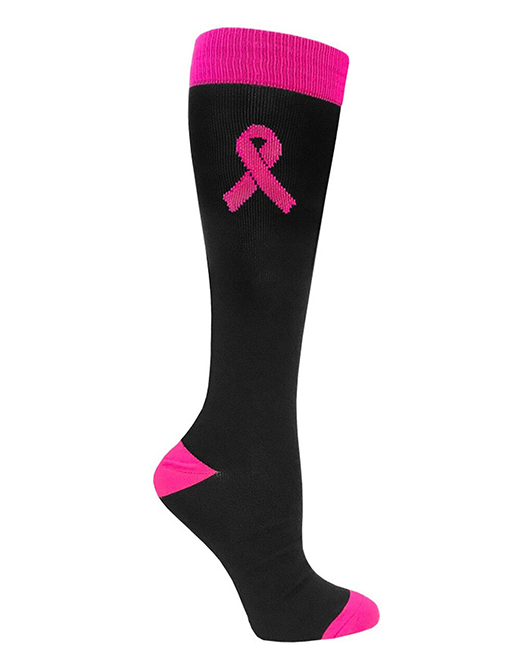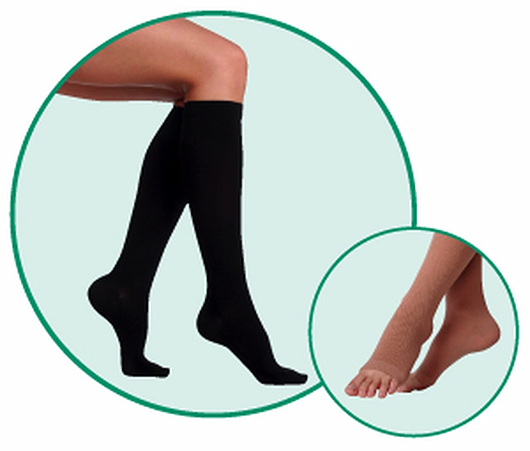How Long Should You Wear Your Compression Socks?
Feb 23rd, 2021
If you’ve never heard of compression therapy, you likely will after your breast cancer surgery or treatment. This is because compression is therapeutic for maintaining optimal blood circulation and preventing lymphedema from developing in your body, two key factors in your wellbeing post-surgery.
While compression therapy can include various garments such as bras and vests, they also come in stockings or socks for your lower body. You may be wondering how something so far away from your breasts, covering your feet and lower legs, can help your recovery?

If you are unfamiliar with compression socks or recently received a doctor’s recommendation to wear them following your breast cancer surgery, there are a few important things to know before you get started. One of these is how long you can wear them and also what to look for when doing so.
People wear compression socks for a variety of reasons, such as alleviating fatigue and discomfort following a strenuous workout or preventing leg swelling while standing for long periods or all day long. They are often prescribed as a treatment for those experiencing deep vein thrombosis and varicose veins as well.
However, for those undergoing breast cancer surgery, these compression socks are most often worn to reduce the risk of pooling lymph fluid in tissues and developing lymphedema, a common occurrence following surgery.
Lymph fluid collecting in tissues, or lymphedema, occurs when lymph nodes are removed or damaged during your breast cancer treatments. A blockage occurs in your body’s lymphatic system, an integral part of your immune system. It can develop shortly after your surgery or gradually appear weeks, months, or even years later.
Why Wear Compression Stockings?
To better understand when and for how long to wear your compression socks, you need to understand the benefits of wearing them following your breast cancer surgery.
Designed to apply continuous graduated pressure to lower legs, compression socks help your body maintain blood flow, reducing swelling and discomfort and improving circulation. These come in knee-high versions and also ankle socks, each one providing the targeted compression you need.
Graduated compression socks exert the most pressure at the bottom of your leg, at the foot and ankle. As it rises up your leg, the pressure lessens slightly. This promotes upward blood flow to the heart and assists with lymphatic drainage as it works against gravity. This compression therapy effectively prevents the development of lymphedema and treats its symptoms once you have it.

Finding pairs to fit you is as easy as going online to Mastectomyshop.com. The Juzo Soft Stocking knee-high socks offer a soft, smooth knit fabric for comfort and the compression needed throughout your day. They also feature a silicone bead band to keep them in place all day long, and they won’t draw undue attention as they blend in perfectly with whatever you are wearing.
How Long Can You Wear Compression Socks?
Compression socks are meant to be worn daily for long periods. Be sure to ask for medical advice regarding the recommended amount of time specifically for you following surgery, however. You may start with a few hours at first to get used to them or be required to wear them all day shortly after your surgery.
You also need to consult your doctor about the level of compression for your needs. Too tight and the compression socks can have the opposite effect and cut off circulation. Too loose and the stocking may not offer the cardiovascular benefits you need.
While wearing your compression socks, watch for signs alerting you to something wrong and then remove the socks immediately. These side effects include:
- Extreme discomfort
- Skin rednes
- Rash or other allergic skin reactions
- Tingling sensation in feet
- Numbness because of a loss of circulation
Also, check with your medical professional to be sure you can wear compression socks with other underlying conditions, such as diabetes.
Remove Compression Socks While You Sleep
Avoid wearing your compression socks through the night. Wearing them at night can lead to the material bunching up in areas, cutting off your circulation. Another reason is that your veins do not require as much help with the pumping of blood upward toward the heart when lying down.
The Key is in the Sizing
The key to comfort and performance with compression garments is to measure your legs accurately and often to determine the best size. Correct sizing is imperative for receiving the healthful benefits of compression therapy.
Sizes range from small to extra large and also include versions for those with larger calf muscles. Measuring your leg size needs to take place before purchasing your first pair of compression socks. Follow this up every three to six months when it's time to buy a new pair.
You can buy these socks in various sizes and colors at MastectomyShop.com. We have specialized staff knowledgeable in compression garments to aid you in measuring and selecting all post-treatment needs.
Find Your Compression Garments on MastectomyShop.com
What better way to find the compression socks you need than through the help of those who specialize in products for breast cancer survivors? Explore our range of medical supply compression garments online today and, if you have questions or need assistance, call our friendly staff at (877) 413-2272.



